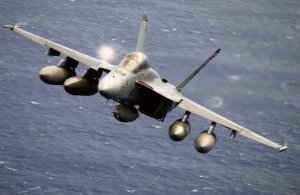While Lockheed Martin has made much of the generational leap in technology that the F-35 Joint Strike Fighter represents, Boeing has taken a more incremental approach to the F/A-18E/F Super Hornet, its offering for Canada’s next fighter aircraft.
Speaking at the Canadian Aerospace Summit in Ottawa this fall, Dennis Muilenburg, president and chief executive officer of Boeing Defense, Space and Security, described a process of technology injection over the life of a fleet that allows for continuous refresh “so that every year the jet has better capability while the cost goes down.”
He dismissed the often used “fifth generation” expression as “a relatively convenient marketing term. My preference is not to think about aircraft in terms of generations. We desire to inject technology into our jets on a continuous basis, not once every generation. I think we have been able to demonstrate that on the F-18 and the Super Hornet.”
In a presentation on innovation and managing risk, Muilenberg said Boeing’s approach with the Super Hornet and other aircraft such as the P-8 Poseidon and V-22 has allowed the company to introduce “leading-edge capability” even as defence budgets decrease.
“Think about an equation where you have a robust production line, you have absolute certainty in terms of cost and schedule, in terms of your ability to produce and deliver jets, you have confidence that those jets have leading-edge technology, and you know exactly what they will cost to support in the field,” he said. “That is an innovation model that we think has budget credibility along with the best capability for our war fighters. That is a new kind of innovation rather than a step function, product introductions that carry risk.”
The United States Navy’s P-8 multi-mission aircraft is built on the Boeing 737 product line and has leveraged “significant commercial technology” for maritime surveillance. The company will take a similar approach with the KC-46 tanker, which is based on the commercial 767 aircraft. That commonality of airframes, along with cross-pollination of systems and upfront design for technology insertion from a growing global supplier base will ensure not only innovation in products, but also “lead to innovation in terms of mission,” he said.
To date Boeing has sold over 600 Super Hornets and EA-18G Growlers. Muilenberg believes that track record should be important to Canada as the government assess risk. “When you need…certainty of procurement, we know precisely when the aircraft will be delivered, what they will cost, and exactly what they will cost when they are in the field,” he said, adding that the Super Hornet would cost half of what the F-35 is projected to require to operate.
The government has yet to announce whether it will reopen the F-18 replacement program to competition, but Boeing wasn’t the only company at the Aerospace Industries Association of Canada’s annual summit to urge government officials to look beyond the F-35.
Yves Robins, senior vice president for European Union and NATO Affairs at France’s Dassault Aviation, spoke directly after a presentation from Diane Finley, Minister of Public Works and Government Services, and said the company’s bid would deliver on the government’s two key objectives for the sector – jobs and growth.
“We are very serious about bringing regional benefits to Canada…If there is a competition, we will transfer all of our technology, including the intellectual property here, with no restrictions,” he said, reiterating a pledge he made in an interview with Vanguard during the Paris Airshow. “We hope, Madame Minister, that the review leads to a full competition where the best solution for Canada wins.”

